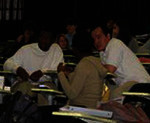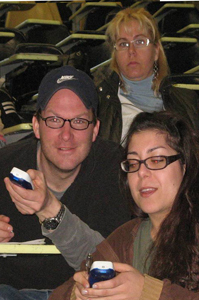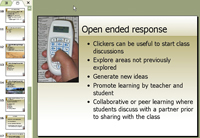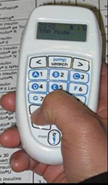Clickers as an Introduction to Nursing
Profweb met with Judith Findlay of the Nursing Faculty at John Abbott College to talk about her research into clickers and teachers’ attitudes to new technology.
Tell me about your upcoming thesis for the Master Teacher Program of Performa.
My thesis is about faculty attitudes towards using new technology such as clickers. The official title is “Introduction of Clickers for Use in Large Nursing Classes”. I’m hoping to complete my thesis this summer.
I’ve been interested in critical thinking in nursing because students must learn to do it, but it’s a difficult concept to teach. My interest in technology is really driven by my desire to motivate and engage students in a large classroom, thus creating an environment to foster this important concept.

Students discussing how to answer questions creates a situation of peer instruction.
I met Peter LaRivière who is the sales person for e-Instuction, an agency that sells clicker hardware. Peter allowed me to use a set of demonstration clickers (40) in my classes. I used them last winter (2007) in a second semester nursing course. My students were more engaged and participative in class and they found clickers to be fun. I felt that teachers who were comfortable using technology would likely benefit from similar positive reactions.
What motivated you to use clickers as the resource to judge changes in teachers’ attitudes towards technology?
Answering questions using clickers is an anonymous activity which is important in a class where: students are aged anywhere from 16 to 55; there is a diverse multicultural component; and there can be language issues. Furthermore, with classes of 88 students, clickers eliminated the problem of always having the same small percentage of students participating. In one case the comfort level was so high that when only one person got the answer to a question wrong, she identified herself and then explained her rationale for her conclusions. Even though I did not understand why she had responded in the way she did, the importance was her comfort level in participating openly in class, even with a dissenting view point.
Was there other evidence that students were engaged?
They weren’t falling asleep. Having taught content in a manner that they thought interesting, teachers in my department despaired when their students nodded off. To date, I haven’t noticed a particular result in terms of student grades or retentions, but I want to see if critical thinking is enhanced with a larger sampling. Unfortunately, there was no control group with which to compare the classes that I used clickers in.
I had 40 clickers for 80 students so almost naturally, my classes promoted peer instruction. Students worked together to come up with the appropriate answer. For one of my classes towards the end of the semester I did a review class using a Jeopardy style game. Without technology this would be a situation of group against group alternating answering questions. With clickers being used in groups of 4 or 5 students, everyone answered every question. At the end, all the students won because they were engaged and participated throughout and had the opportunity to respond to every question.

Students using clickers are engaged.
The other thing that clickers allowed me to do was to ask students to answer a leading question and therefore to clear up misconceptions right away. The biggest advantage in these classes was that I get immediate feedback on whether the students understood the lessons whereas in traditional teaching it would only become apparent at the exam; too late for me to make a difference.
For the reasons stated above, I was already interested in technology and clickers in particular and thus it became a natural topic for me to research more fully for my thesis. I wanted to see what instructional strategies teachers used in the classroom and if they were receptive to using new technologies such as clickers.
What’s your methodology?
I used a questionnaire and a presentation to the faculty about clickers. The questionnaire was on basic computer usage as well as determining what instructional strategies the respondents used. There were Likert scale and open-ended questions.

A slide from the PowerPoint presentation that was used.
What was your initial hypothesis?
I originally wanted to find out how receptive the Nursing Faculty was to learning about information technology. Subsequent to my work, the Nursing Faculty requested clickers on their capital budget. As well, the Nursing Faculty has asked to borrow a set of clickers for the upcoming year. Other programs at John Abbott have used clickers and shown interest in using them in the future, as well. I feel that much of this positive perception in the Nursing Faculty has been due to the interactions I have had with faculty and students in the past year and the positive support from e-Instruction. The gradual introduction of the concepts and the positive reinforcement through staged activities can lead to dedicated professionals using new concepts as another technique to reinforce their teaching activities.


